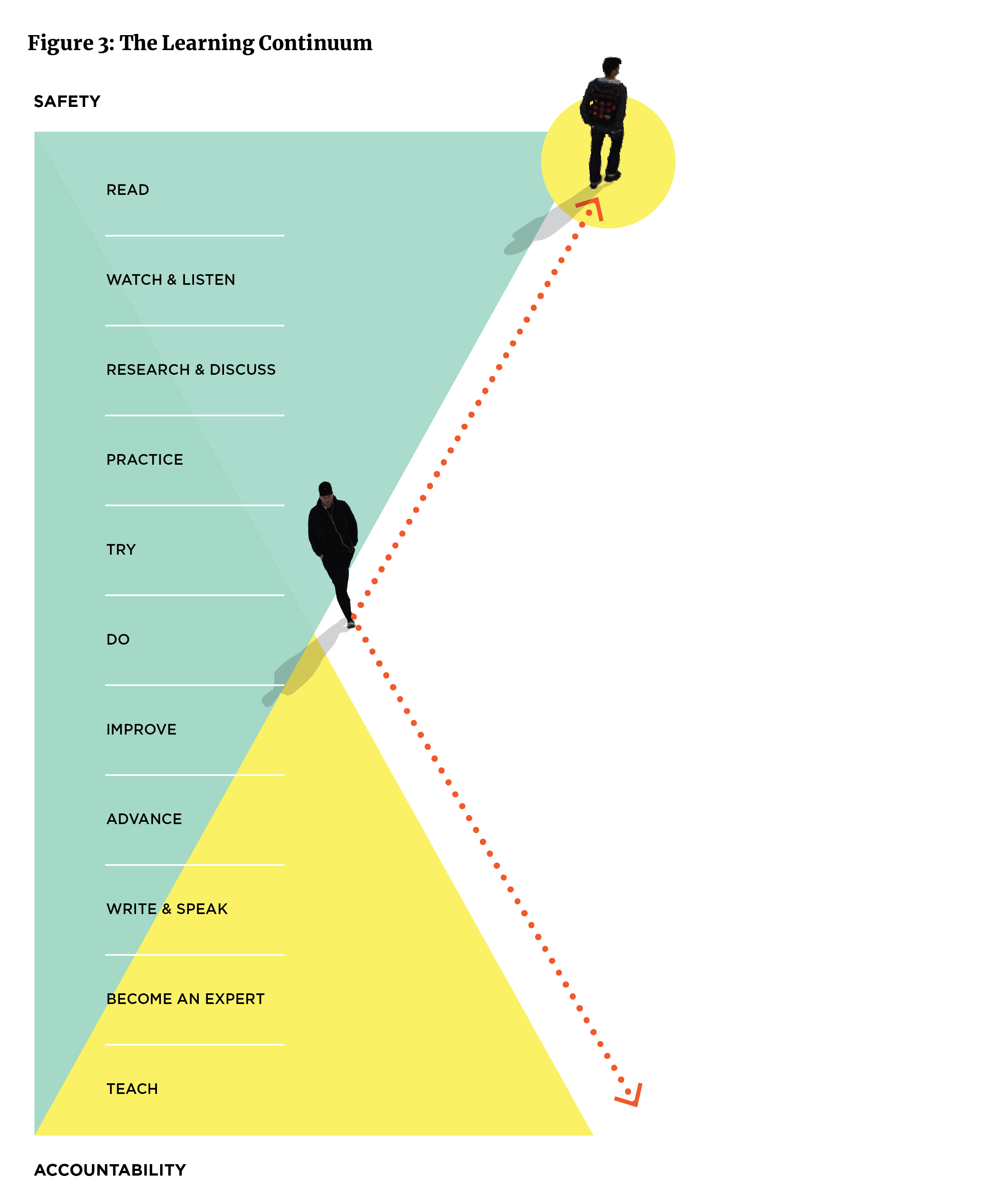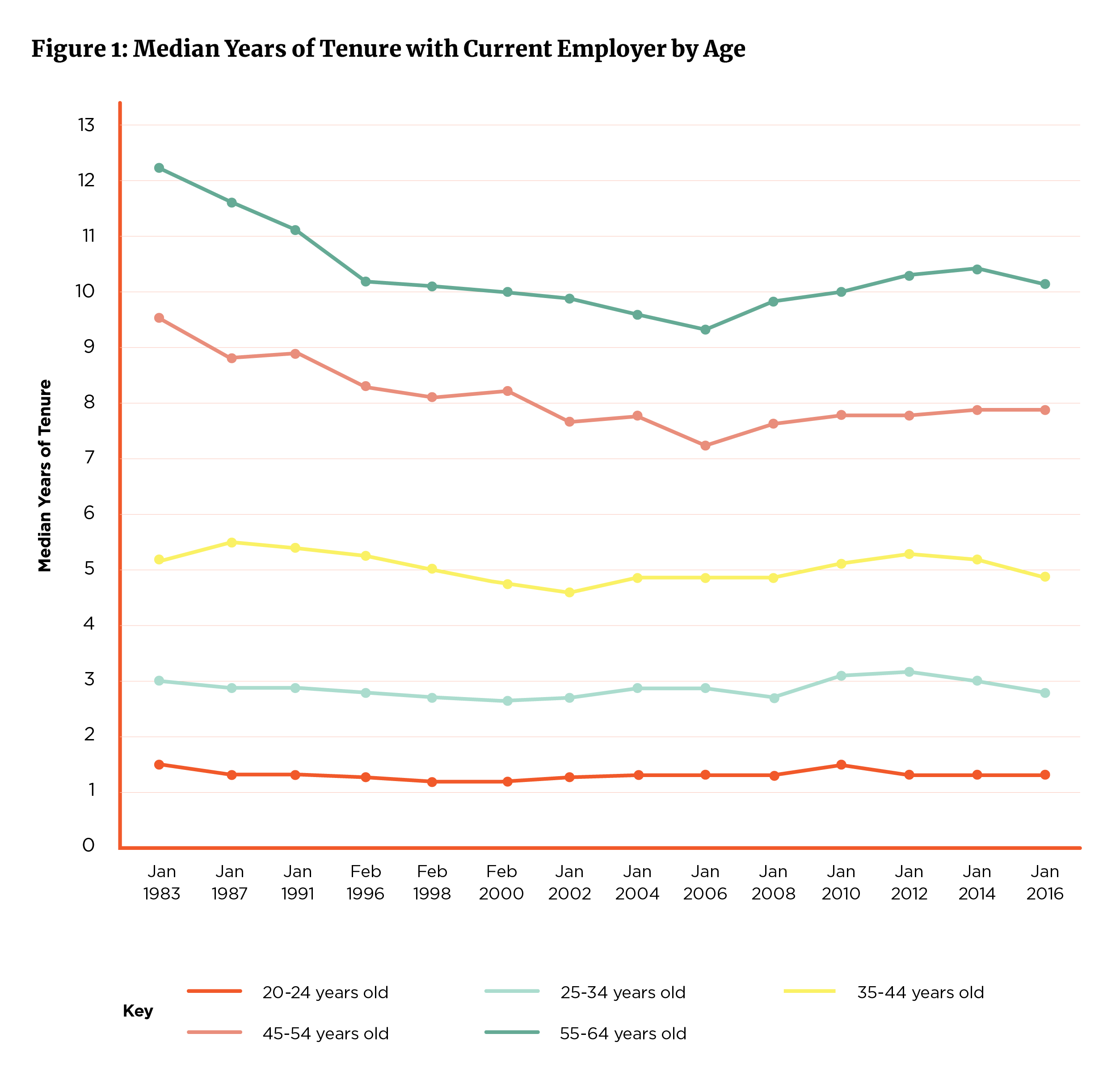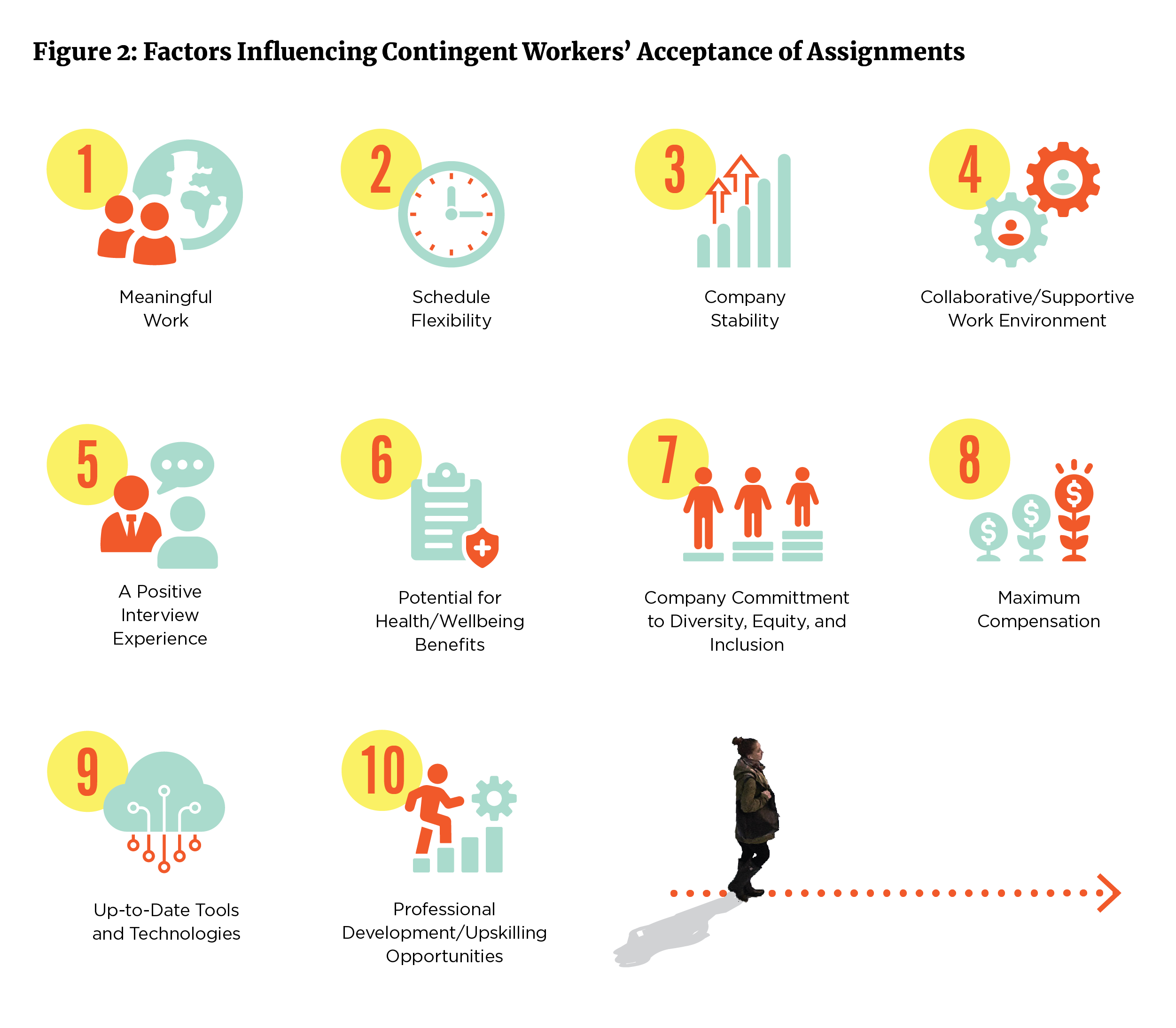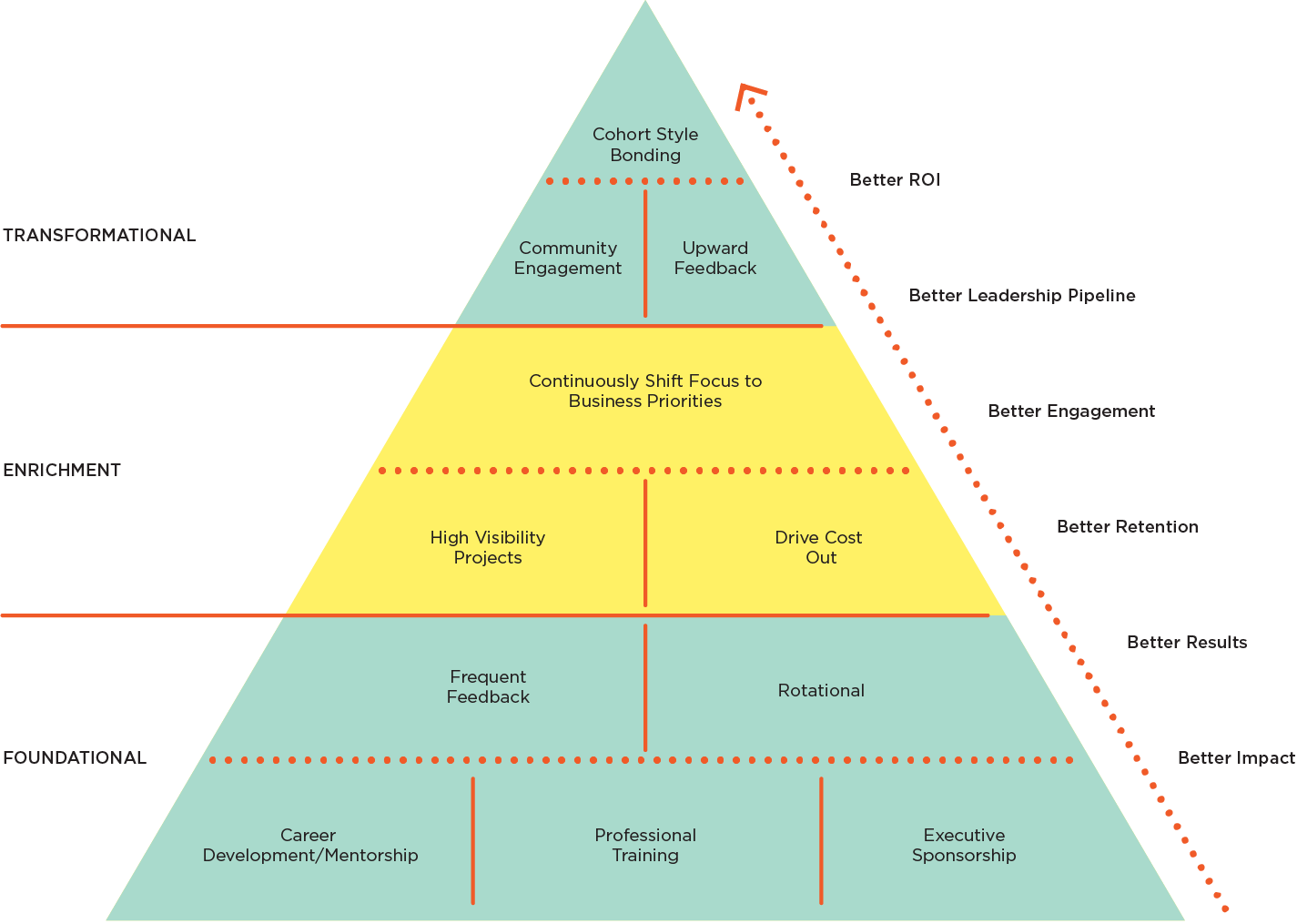In today’s corporate climate, retaining next-generation top talent is more important than ever. With articles such as “Millennials: The Job Hopping Generation” and “Millennials or Gen Z: Who is doing the most job-hopping?” you would think this problem is getting worse with the younger generations. As a Millennial myself, I hear the common advice that the best way to increase your salary faster is to change jobs. But is this truly unique to Millennials?
The short answer is no. According to the Department of Labor (see Figure 1), Millennials (ages 25-34 at the time of this report) have remained consistent with around three median years of tenure with a current employer over the past 30 years. In fact, Millennials mirrored or even exceeded the median tenure rates seen in prior generations. The data demonstrates that job-hopping is attributable more to age than the dynamics of the generation.
Source: Department of Labor
However, that does not mean things are still the same. Meaningful work is now at the top of the list with other cultural factors rounding out the top 10. Pay rate is no longer the most important factor in choosing or leaving a job and did not crack the top five in a recent survey of contingent workers, as shown Figure 2 (e.g., contractors, consultants, advisors). This is not to say maximizing compensation isn’t essential; it is and comes in at number eight. Statistically speaking, these factors are relatively close, but the increasing weight of other conditions proves that it takes more than big checks to retain top talent. For information about engagement drivers and levers, check out The Jabian Journal article Exploring the Dynamics of Employee Engagement, Fall 2016.
To attract and retain top talent, foster growth, increase engagement, and drive success, organizations are investing in leadership development programs (LDPs). The top organizations have created programs specifically for young professionals and emerging leaders because they recognize the value of investing in young talent. Did you know that companies with high-quality leadership development programs that extend below senior levels are 4.2 times more likely to financially outperform those that don’t on revenue growth, operating margin, EBITDA, and return on equity?1 Companies that incorporate emerging LDPs in their full pipeline also have higher-quality senior leadership and more diversity at every level.
Through this article, you’ll learn about the benefits of investing in leadership development programs, including increased retention, self-funded investments through cost savings, and higher employee satisfaction. We’ll also explore the different types of leadership development needs that fall under each category of Jabian’s Hierarchy and provide tips and best practices for accelerating development at each level. So, let’s dive in and explore how you can create a leadership development program that delivers real results.
Jabian’s Hierarchy of Leadership Development
How we learn has been researched, and continues to be researched, extensively. In the 1970s, Lombardo and Eichenger revealed formal learning, such as classroom training and reading, only accounts for roughly 10 percent of overall learning. In contrast, approximately 20 percent of learning occurs through observation and watching others perform a task, while the majority of learning, around 70 percent, comes from experiences gained on the job.
Jabian has developed The Learning Continuum, which organizations can use to help people progress toward mastery in each domain (see Figure 3; Jabian Journal “A Model for Master,” Fall 2014). The continuum is based on the activities people do while learning from reading, listening, watching, and discussing, through doing, advancing the craft, and eventually giving back. Indeed, only the far-left side of the continuum involves formal learning.
Building on this research, Jabian has developed a framework called the Jabian Hierarchy of Leadership Development: Foundational, Enrichment, and Transformational Needs. The hierarchy is built on the premise that leadership development programs have tiers of effectiveness. As programs progress up the hierarchy, they provide experiences that allow young leaders to accelerate and fulfill their potential. Organizations also enjoy better retention, increased productivity, a full pipeline of well-rounded leaders, and much more to be discussed.

Foundational Needs
There are many examples of companies with rotational leadership development programs. General Electric was an early adopter, with one of its programs dating as far back as 1910. Now over 25 percent of its top leaders have started in their LDP.3 Carol Tomé, the CEO of UPS and former CFO of The Home Depot, visited GE and was inspired to create a best-in-class LDP at The Home Depot in the early 2000s (now known as the Assurance and Advisory Management Program). Cox Enterprises, Delta Air Lines, Chick-fil-A, Siemens, The Clorox Company, GEICO, and Cigna, just to name a few, also have LDPs. Each is structured a bit differently. Some are three-month-long rotational projects; some are six months, and some are two years. The length of time depends on the complexity of the business, tradeoffs of the depth of knowledge versus breadth, and speed to impact.
Frequent Feedback
Mid-year and end-of-year evaluations don’t cut it if your goal is to accelerate professional development. Frequent, specific, and tangible feedback is vital to accelerated growth—at minimum every three months but can be more often (e.g., every six weeks). More important is a framework of skills to evaluate and track, which is the highest determinant of the success of leaders in your company. This can vary by industry and company culture but should include hard and soft skills and be revisited every three to five years to adapt to changing environments. Some examples of skills are managing time, delivering results, knowledge of the business, critical thinking, influencing others, managing relationships, and presenting effectively.
Rotational
A rotational leadership development program that exposes participants to various roles and departments can help develop a breadth of knowledge and produce more well-rounded leaders. A leader will make better decisions when they can consider and understand the impacts on all functions of a business — operations, finance, technology, marketing, supply chain, human resources, etc. The number of rotations and length within each rotation should be balanced with company structure, complexity, and maximizing value to the company (i.e., more projects or more experience). Additionally, a rotational program can help foster a culture of continuous learning and development within an organization, as participants will be constantly challenged and exposed to new experiences. This can also increase employee engagement and retention, as individuals feel invested in and valued by the organization. Once a young leader has been through all of the rotations, they should be able to isolate areas of interest to pursue.
Career Development / Mentorship
Career development and mentorship are essential components of any successful leadership development program. Young professionals need guidance and support as they navigate their career paths; a one-on-one mentor relationship can provide that. Mentors offer insights into their career journeys, provide advice on navigating workplace challenges, and help identify growth opportunities. Whether the mentor is chosen by the young professional or assigned by the program, having someone to turn to for guidance and support can be invaluable for career development. Typically, allowing mid-level professionals to choose their mentor lets people align their personalities and interests. However, new professionals coming out of school would benefit from having a mentor assigned on day one.
Professional Training
Formal training accounts for 10 percent of overall learning. Yes, this may seem low, but 94 percent of employees won’t quit if they’re offered training and development opportunities, and 45 percent of workers would stay at a company longer if it invested in their learning and development.4 You get bonus points if you align the professional training topics with the criteria designated for frequent feedback.
Executive Sponsorship
Programs will fail without the full support of executives. As young professionals work on projects for partners in the business, both sides need to know that this is fully endorsed by executives, preferably the CEO. Leadership development programs with strong CEO support were 50 percent likelier to be best-in-class.5 Before you embark on the journey of creating an LDP, get leadership on board.

Enrichment Needs
Moving beyond the foundational aspects of leadership development programs, enrichment needs play a critical role in establishing an impactful partnership with the business and creating a meaningful work environment. Addressing enrichment needs to ensure a comprehensive and impactful program that nurtures young professionals and empowers them to thrive in their roles. Let’s explore each of these components in detail to understand their significance in driving leadership excellence.
High-Visibility Projects
Including high-visibility projects in a leadership development program is crucial for engaging young professionals and the business partners involved. These projects offer opportunities to work on strategic initiatives, showcasing employees’ skills to key stakeholders and building their reputations within the organization. Engaging in such assignments enables them to stretch their capabilities, think strategically, and collaborate with cross-functional teams, fostering invaluable learning experiences. Providing real problems instills a sense of ownership and accountability. Leaders can provide a safe place by building in time to review and support the work, along with regular feedback, which ensures the success of these projects and maximizes the development potential of emerging leaders.
Continuously Shift Focus to Business Priorities
Business priorities shift quickly. When the COVID-19 pandemic began, business quickly shifted to meet the demands of a changed environment. Retail stores were suddenly implementing curbside pickup on a larger scale. Restaurants shifted to majority pick-up and delivery orders. Flexibly moving resources and focusing on new priorities are hallmarks of best-in-class organizations and market leaders. This bodes true for leadership development programs as well. After all, being a good partner with the business and working on high-impact projects means working on the top business priorities. Partnerships with other departments are built and sustained by the circular repetition of offering help, providing excellent project delivery, asking for feedback, following up on action items, and being professional, which involves development training. A good leadership development program identifies projects based on business needs and is sought out by business partners due to credibility.
Drive Cost Out
Leadership development programs are not exactly revenue generators — generally speaking. However, what if I told you they can fund themselves? With a focus on high-impact cost savings projects, programs can identify cost-out opportunities at scale. Programs should equip participants with the knowledge and skills to identify cost reduction and process improvement opportunities. If you can find cost savings for a business partner, you are also reinforcing a good partnership and reputation.

Transformational Needs
True meaningful work for young leaders will develop a strong sense of identity, purpose, and higher engagement within the organization. By incorporating these transformational components into leadership development programs, organizations can cultivate a supportive and inclusive environment that empowers emerging leaders to reach their full potential and make a meaningful impact.
Cohort Style Bonding
Creating cohorts or groups that go through the program together, take the same and concurrent professional training, and learn from one another’s shared experiences not only enhances engagement and motivation but also creates a network of trusted colleagues who can provide ongoing support and guidance throughout their careers. This sense of collaboration and peer support can be expanded upon by other activities such as group discussions, networking events, book clubs, committees (e.g., DEI, social, community service), and team happy hours to provide a sense of belonging. A strong network of colleague alumni will also amplify a good feedback loop of business partners in the future.
Community Engagement
Encouraging participants to actively engage with the broader community, both within and outside the organization, provides them with a sense of purpose and a deeper understanding of their role as leaders. By participating in volunteer activities, corporate social responsibility initiatives, or community outreach programs, emerging leaders develop empathy, social awareness, and a commitment to making a positive impact beyond the workplace. Community engagement not only strengthens their leadership skills but also enhances the organization’s reputation, cultivates meaningful connections, and contributes to the overall well-being of society.
Upward Feedback
Do you want to go the extra mile and build trust with the participants of your program? Do you want young leaders to learn how to be more effective leaders? Frequent feedback is a foundational need for professional development. Upward feedback is a higher-level form of development. This seldomly used activity provides precious insight into what the participants are looking for in their own experience and gives young leaders 360-degree feedback.

Conclusion
Well-structured leadership development programs can address most, if not all, of the top 10 factors influencing choosing or quitting a job. Foundational needs provide professional development, enrichment needs provide meaningful work and up-to-date tools and technologies, and transformational needs provide a collaborative work environment.
The ROI of leadership development programs can be hard to prove, which is a common barrier for companies. Structuring the program as a cost-out center can provide the business case that you may have been missing. And even if you don’t believe the ROI, the cost of not doing it can be even higher (i.e., turnover). Every time a company replaces a salaried employee, it costs six to nine months’ salary, on average, due to recruiting costs, onboarding, lost productivity, training, and more.6 The turnover cost can be as high as 213 percent for C-suite positions.
The benefits of leadership development programs and investing in young professionals are endless, and the culture instilled in these young leaders will slowly drip into and throughout the entire organization as they graduate and lead other departments. By training these small cohorts of leaders, you can watch best practices spread like seeds, taking root, and flourishing across the organizational landscape.
Whether you are starting from square one or already have a leadership development program in place, Jabian’s Hierarchy of Leadership Development can be employed as a valuable framework to assess the effectiveness and comprehensiveness of your program. It serves as a guiding rubric to use for measurement and identifies areas of improvement, tracks progress, and ensures that all essential components, from foundational needs to enrichment and transformational needs, are addressed. Or it can serve as a guide in creating a first-ever, best-in-class program for your organization built with the support of the young professionals that will lead your company for years to come.
Sources:
- https://media.ddiworld.com/research/global-leadership-forecast-2018_ddi_tr.pdf
- https://www.harvardbusiness.org/news/only-7-of-organizations-believe-their-leadership-development-programs-are-best-in-class-according-to-harvard-business-publishing-state-of-leadership-development-survey/
- https://jobs.gecareers.com/global/en/global-leadership-programs
- https://www.zippia.com/employer/employee-training-development-statistics/
- https://www.harvardbusiness.org/news/only-7-of-organizations-believe-their-leadership-development-programs-are-best-in-class-according-to-harvard-business-publishing-state-of-leadership-development-survey/
- https://www.peoplekeep.com/blog/employee-retention-the-real-cost-of-losing-an-employee#:~:text=Some%20studies4%20predict%20that,and%20role%20of%20the%20employee.



